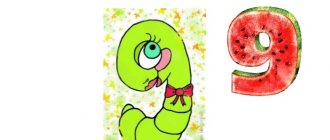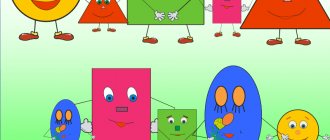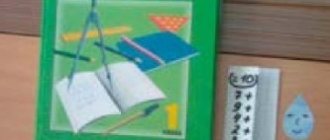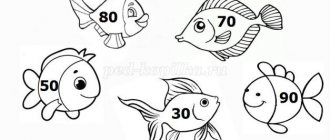Notes on FEMP “Introduction to the number 0”
Notes on FEMP No. 12 10/12/2021
Program content
• Introduce the composition of the number 10 from ones.
• Introduce the number 0.
• Continue learning to find the previous number to the named one, the next number to the named one
.
• Clarify ideas about the weight of objects and the relativity of weight when comparing them.
• Form ideas about temporary relationships and learn to denote them with words: first, then, before, after, earlier, later
e.
Didactic visual material
Demonstration material.
A ball, a nesting doll, pictures depicting the seasons, cards with numbers from 0 to 9, 9 circles of the same color, a magnetic board, 3 opaque buckets with different amounts of millet.
Handout.
Cards with numbers from 0 to 9, colored circles (12 pieces for each child).
OD progress
Part I.
Guys, we all love adventures, riddles and secrets. Yesterday I received a letter by mail from the navigator Captain Mathematics. He invited us to go on a trip in search of treasure. The letter contained a map (unfolds the map). This map will show us the way to the treasure. Finding the treasure will not be easy. You will need to: answer questions, and we will move from one place to another, guided by the map.
Game exercise “Name the number.”
Children stand in a semicircle. The teacher reminds: “A number has two neighbors: one number is one less, it is the previous one, the other is one more, it is the next one. State the previous number of five.”
The teacher passes the ball to the child, who calls the number 4 and returns the ball to the teacher.
The teacher offers 3-4 more similar tasks to determine the previous and subsequent numbers to the one named.
Part II.
Game exercise “Collecting multi-colored beads.”
Children have sets of colored circles. The teacher invites them to make beads for a nesting doll from 10 multi-colored beads.
At the end of the task, the teacher clarifies: “How many beads did you take? How many beads of what color? How did you come up with the number ten? How many ones are in the number ten?
Part III.
Game exercise “How much is left?”
There is a number row on the board (from 1 to 9).
The teacher invites the children to lay out cards with numbers from 1 to 9 on the table. Then he draws their attention to the board on which there are 9 circles of the same color, asks them to count them and show the corresponding card with the number.
The teacher begins to remove one circle at a time from right to left, and the children show with a number how many circles are left. When there is not a single circle left, the teacher explains: “There is a number that shows that there is not a single object here. This is number zero."
Summary of GCD for the preparatory group on FEMP. Number 8. Number 8. Journey to the land of knowledge
Summary of GCD for the preparatory group for FEMP Topic: "Number 8. Number 8. Journey to the land of knowledge"
Integration of educational areas:
socio-communicative development, cognitive development, physical development.
Tasks:
Social and communicative development:
- Develop the ability to focus on the task at hand
- Develop the ability to work in a team, perseverance, the ability to understand and independently carry out the teacher’s tasks
- Cultivate a kind, respectful attitude towards others, work independently with handouts.
Cognitive development:
- Strengthen your understanding of the composition of the number 7, counting skills within 7
- Continue to form temporary representations (days of the week)
- Introduce the formation and composition of the number 8 and the number 8;
- Strengthen the ability to correlate the number of objects with a number;
- Fix the name of the geometric shapes; relationship between the whole and the parts
- Develop logical thinking
- Give ideas about true and false judgments
Speech development:
- develop children's free communication, speech, memory, attention, thinking
- activate children's vocabulary.
- to cultivate curiosity, mutual assistance, and self-esteem skills in children.
Physical development:
- develop motor activity and fine motor skills.
Methods and techniques:
practical - exercises, games; visual – observation, demonstration; verbal – conversations, questions, artistic expression, teacher’s questions, children’s answers.
Logic of educational activities
Activities of the teacher
Activities of students
Expected results
Organizing time. IN.
- Hello guys - Let's stand in a circle, hold hands and smile at each other
V.
- In a wide circle, I see, All my friends have stood up. We will now go to the right, And now we will go to the left, We will gather in the center of the circle, And we will all return to our place. Let's smile, wink, and let's start the lesson.
. Children and their teacher stand in a circle. Children perform exercises in accordance with the text.
Shows an emotional attitude to a literary work.
IN.
- You will all listen carefully, answer questions with complete answers, do not shout, do not interrupt your comrades, listen to the teacher.
D/U "Country of Knowledge of Mathematics." V.
— Guys, what can you travel on?
V.
— You and I are going on our journey by train. To do this we must buy tickets.
Children listen carefully to the teacher. They answer the teacher’s questions and offer travel by bus, plane, boat, train, or bicycle.
Shows interest in travel and modes of transport.
.
Game exercise with the ball “Train Ticket”
To get on the train you need to know the forward and backward counting to 10. You count by passing the ball to each other. V. - you are great, you counted well and we can all take our seats on the train.
Children count forward and backward. The music “Locomotive from Romashkovo” sounds, the children go to their places at the table.
Shows interest in the game and follows the rules of the game.
Game task “Number Neighbors” V.
I call the number, and you call it Neighbors
Name the neighbors of number 2; neighbors of number 4; neighbors of number 5; neighbors of number 6
Listen to the task and complete it.
Agree with partners on how to play; follow the rules of the game.
D/i “In what fairy tales does the number “7” appear? 1. In which fairy tale were there seven kids? 2. Which flower fulfilled all the wishes of the girl Zhenya? 3. What is the name of the fairy tale where there were gnomes and one girl? 4.What is the name of the fairy tale by A.S. Pushkin where there were seven heroes? IN.
- How many days are there in a week?
What is the seventh day of the week? V.
- The number 7, indicated by the number "7"
V. - Well done!
Now we have reached the first stop.
Listen carefully and answer questions (Children's answers: “The Wolf and the Seven Little Goats”, “Snow White and the Seven Dwarfs”, “The Flower of the Seven Flowers”, “The Tale of the Dead Princess and the Seven Knights”)
Shows interest in fairy tales and curiosity.
The first stop is Lesnaya station. Guess the riddles and find out who lives at this station. Puzzles:
- Angry touchy-feely
Lives in the wilderness of the forest. There are a lot of needles, but not one thread.
- Clubfoot and big, He sleeps in a den in winter. He loves pine cones, he loves honey, Well, who can name it?
- Gray and toothy, created a commotion in the forest. All the animals ran away. Scared the animals...
- Long ears, fast legs. Gray in summer, but not a mouse, white in winter. Who is this?
5. Touching the grass with his hooves, a handsome man walks through the forest, walking boldly and easily, with his horns spread wide. 6. Less than a tiger, more like a cat, Above the ears are horns. It looks meek, but don’t believe it: this beast is terrible in anger! 7. Who deftly jumps through the trees and flies up into the oak trees? Who hides nuts in a hollow and dries mushrooms for the winter? How can you call these animals in one word? How many animals are there in total? The teacher counts and takes off. The animals are preparing for winter, they have a lot to do, and we will move on.
The teacher asks riddles, the children guess them. At the same time, they examine and count the pictures of the guessed animals displayed on the board.
Shows curiosity and a desire to learn more about animals.
D/I "Digital"
Q. - what do you see on the board? Guys, there are red and blue squares on the board in front of you. How many squares are there in total? (7) Q. How many red squares are there? (6) how many blue ones? (1) How did we get the number 7? to 6 +1=7 D/game “Day-Night” V.- Look carefully at the squares and remember.
The teacher changes the blue square to a red one. The day has come, we open our eyes, “What has changed?” D. - Blue was changed to red. How many blue squares are there? (7) Night, close our eyes. The teacher adds one red square. Day, what has changed? Added another red square. How much is it in total? Let's do the math. (8) How did we get the number 8? We are at 7 +1=8
They willingly work in a team, show respect to each other. (Children close their eyes, night has fallen. They open them - day.)
Shows interest in the game.
D/u “Number and figure 8” The number eight is indicated by this number. Number 8 is so delicious, it comes from two bagels. IN
.
– What number lives to the right of the number 8? (7). To the left of the number 8? (9) Is there an eighth day of the week? (no, after 7, again the first day of the week) What is the name of the holiday whose name contains the number 8? (March 8) V.
- Let's take a close look at the figure. What does it look like (children's answers) pictures (tumbler, matryoshka, pear)
The number 8 is displayed on the board. They listen to the teacher and answer questions. Children draw the number 8 in the air like a fox with its nose in the air.
Able to listen, count and follow the rules of the game. Draws a number in the air independently.
Physical education minute.
V.
- You are probably tired? Well, then everyone stood up together. They stomped their feet, patted their hands, reached up to their toes, turned to the right, left, and quietly all sat down. We close our eyes tightly, count until 8, open them, blink and continue to work.
Listen to the text and perform actions according to the text.
Shows interest in participating in outdoor games and doing physical exercises.
Composition of the number 8 "House" on a board with circles.
Q. - What is the number of this house?
(8) How to divide the number 8 into 2 smaller numbers? How many circles do you need to add to make the number 8? The teacher shows a table with squares and discusses the options with the children: 6 and 2; 5 and 3; 4 and 4; 3 and 5; 2 and 6; 1 and 7;7 and 1; Conclusion
: the teacher says it can be composed in different ways and lists all the options according to tables 1 and 7; 2 and 6; 3 and 5; 4 and 4; 5 and 3; 6 and 2; 7 and 1; how many options we have for the composition of the number 8 V. - Well done! We did well. Let's move on. In the meantime, we will go to the next station and play a game
Listen to the teacher and answer questions.
Divides the number 8 into two smaller numbers.
Didactic game: “It happens - it doesn’t happen”
1. Is there a circle with three corners? (no, a triangle has three corners) 2. Do a squirrel and a baby squirrel have 4 tails? (no, 2 tails 1 +1=2) 3. Does a bunny have 4 legs? (Yes. A hare only has 4 paws) 4. Is there a round square? And why? (No. A square has four corners) 5. Do foxes and baby foxes have only 4 ears? (Yes. A fox has 2 ears + a fox cub has 2 =4)
They answer the teacher’s questions and show great interest in the game.
Station – “Geometric Figures”. What geometric shapes do you know? (Children call) Q. - What geometric figure is in my hands? Take the same geometric figure in your hands. The teacher shows the children a circle, asks them to name a geometric figure and divide it into 2 equal parts, then asks: how many parts have you divided the circle into, what can you call each part? What is more: a whole or ½ What is less: half or a whole? The teacher asks the children to divide the circle again into two equal parts: how many parts are there in total? (4) How can each part be called? What is greater: a whole or ¼? Which is smaller: ¼ or a whole?
Children name geometric shapes and independently divide the circle into 2 or 4 parts.
Knows geometric figures.
-Today we made a fascinating journey through the land of “Knowledge”. Did you enjoy the trip? What did you like? What was interesting? What number and figure did you meet? You guys are great, I really enjoyed working with you. I want to give you stickers - emoticons - as a souvenir of our lesson, which you can stick on your notebooks. The teacher praises the children.
Answer the teacher's questions.
Shows friendly emotions
In the fifth year of life, the method of familiarization with numbers is simple and specific: demonstration of a number and analysis of its outline, subsequent recognition of it, tracing the outline with the index finger, laying out sticks (strips of paper), modeling from plasticine, learning poems about each number, etc.
In the older group, children continue to become familiar with the numbers 6-9 and 0. Moreover, familiarization with numbers is carried out simultaneously with the formation of knowledge about the formation of numbers and counting within a given number. The work methodology becomes more varied and detailed, as sets, numbers and numbers are compared with each other. Considerable attention is paid to the image (outline) of the number. For example, children are asked to shade the outline image of a number on a piece of paper (the width of the number is approximately 0.5 cm). Children complete tasks, and the teacher helps them.
Preschoolers are introduced to each individual number, relating it to the number through actions with object sets. To do this, the teacher demonstrates the number, asking the children to look at its outline; children create a corresponding set by putting aside a certain number of objects; trace the outline of the number with the index finger of the right hand, assimilating its outline. To consolidate acquired knowledge, various didactic games such as “Errand”, “Shop” are used, as well as exercises: indicate a number that is one more (less) than the one named (the number should be shown), etc.
When familiarizing yourself with numbers, specially made cards are widely used (Fig. 26). The card is divided into two unequal parts: the left one is smaller, the right one is larger. At the bottom of the card along its entire length, a strip of paper is glued to form a pocket. A card with a number is placed on the left side, and a blank sheet of paper on the right side, on which the child must draw as many objects as the number shows.
In kindergarten they are not taught to write numbers, but it is very important that children learn the correct direction of hand movement when writing different numbers. An effective way to do this is to trace the outline of a number: children trace the number with their index finger, maintaining the direction of movement, practice writing numbers in the air, lay it out from counting sticks, and sculpt it from plasticine. During a walk, you can invite children to write a number with a stick on the sand, earth, snow, lay it out of natural material, etc.



